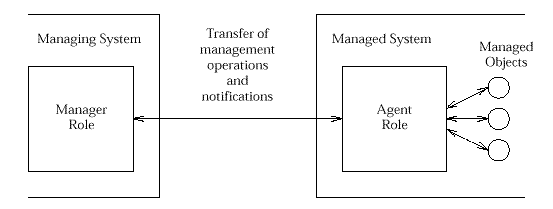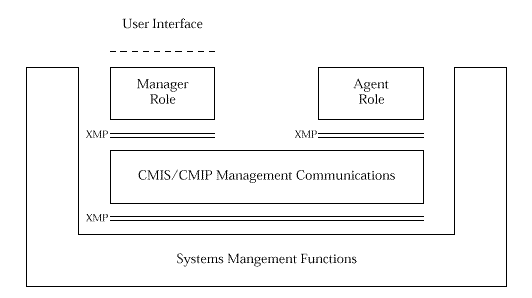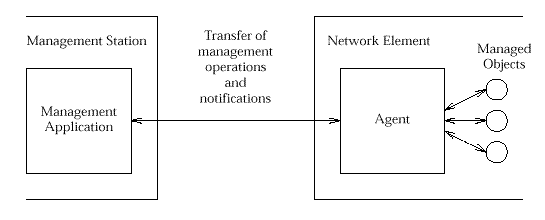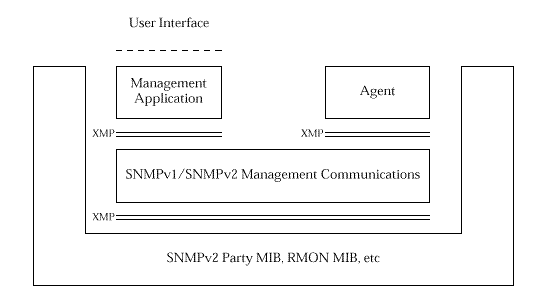
As part of XSM, X/Open has defined a Management Protocol API (XMP) (see reference XMP) which provide consistent access to both the ISO/CCITT and Internet Management Services.
OSI Management is described in a large number of standards, including the OSI Management Framework, ISO/IEC 7498-4, the Systems Management Overview, ISO/IEC 10040, and the Management Information Model, ISO/IEC 10165-1. Managed Objects are defined using the Guidelines for the Definition of Managed Objects (GDMO), ISO/IEC 10165-4. The OSI management protocol is defined in the Common Management Information Service (CMIS) Definition, ISO/IEC 9595, and the Common Management Information Protocol (CMIP), ISO/IEC 9596-1.
The basic model for OSI management communications is shown in

The figure shows a Manager in a managing system communicating with a managed system containing a number of Managed Objects. The managed system contains an agent, which is responsible for implementing the functionality needed to effect the operations on the Managed Objects requested by the Manager and communicated by the protocol.
Information flowing between the components of the system is divided into two categories, management operations performed on the Managed Objects, and operation results and unsolicited notifications originated by the Managed Objects.
The agent process provides access to the Managed Objects. It may also be responsible for the local logging and distribution of event reports that are generated when particular events occur in the managed system.
Information is transferred using the CMIP protocol, which is an OSI application layer protocol specifically intended for the purpose of transferring information concerning Managed Objects. CMIP provides the CMIS service, which includes the following:
The OSI management model is defined in terms of a single management interaction. However, a system may act as a managed system in one interaction and as a managing system in another. Thus an agent may in its turn act as a Manager to other agents, thus providing the "cascading" capability described in the Reference Model.
In additions to the elements identified so far, there is a further set of specifications called Systems Management Functions (SMF). These specifications are intended to define common facilities that can be applied to particular Managed Objects corresponding to different Resources. The SMFs include the following:
The components of the OSI management model provide all the elements
described in the Reference Model. They allow for the
implementation of the necessary functionality to be provided at
the most appropriate place in the management system, and
specifically provide for the "cascading" of management to allow
composite management functions to be implemented.

Internet Management is described in a large number of Request For Comments (RFCs) published by the Internet Engineering Task Force (IETF). Two versions of the Internet Management framework have been defined.
The basic model for Internet management communications is shown in

Information flowing between the components of the system is divided into two categories, management operations performed on the Managed Objects, and operation results and unsolicited notifications originated by the Managed Objects.
The agent provides access to the Managed Objects. It may also be also responsible for detection of unsolicited notifications that are generated when significant events occur in the network element.
Information is transferred using the SNMP protocol, which is an application layer protocol specifically intended for the purpose of transferring information concerning Managed Objects. Internet Management RFCs do not specify an explicit service interface for SNMP. However, SNMP defines protocol data units which support operations and notifications that are conceptually very similar to those described previously for ISO/CCITT management. RFC 1449 further defines how SNMPv2 protocols can be used over a variety of transports, most often the connectionless UDP/IP. Finally, RFC 1452 defines methods for coexistence between versions 1 and 2 of Internet Management.
The Internet management model is defined in terms of a single management interaction. However, an SNMPv2 entity may act as a management station in one interaction and as an agent in another. Thus an SNMPv2 agent may in its turn act as a management station to other agents, providing the cascading capability described in the Reference Model. The Administrative Model defined by RFC 1445 and the Manager-to-Manager MIB defined by RFC 1451 describe this mode of operation for SNMPv2. No equivalent RFCs exist for SNMPv1.
In additions to the elements identified so far, there is a further set of RFCs which collectively define security services for SNMPv2. These RFCs include the following:
Except for the latter specification (RFC 1447), SNMPv2 RFCs do not specify any features equivalent to those defined by ISO/CCITT Systems Management Functions. However, RFC 1271 defines a Remote Network Monitoring (RMON) MIB which provides limited notification control analogous in some respects to the ISO/CCITT event management SMF.
In addition to the RFCs defined thus far, there is a further set of RFCs related to specification of MIBs for use with SNMPv2. These RFCs extend the management information specifications provided with SNMPv1 by adding the following features:
The components of the Internet management model provide all the
elements described in the Reference Model. They allow for the
implementation of the necessary functionality to be provided at
the most appropriate place in the management system, and
specifically SNMPv2 provides for the "cascading" of management to
allow composite management functions to be implemented.

Note that Internet Management model does not explicitly provide for specification of common services as described in the Reference Model. However, service specifications can and do exist, represented as specialised MIBs such as the SNMPv2 Party MIB and the RMON MIB.
| Contents | Next section | Index |